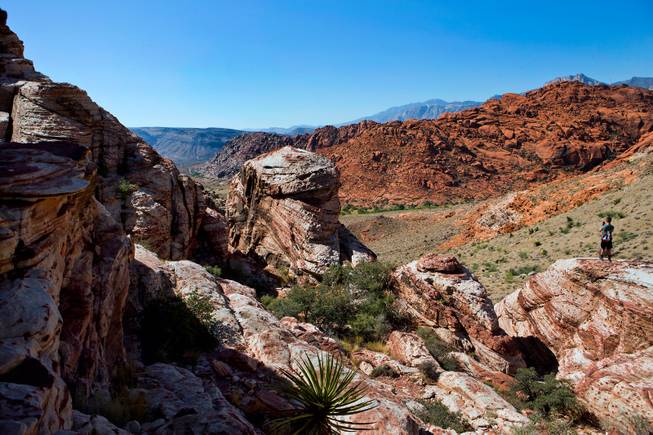
A young hiker takes in the valley view from atop the Kraft Mountain Loop Trail within the Red Rock Canyon on Monday, Sept. 5, 2016.
Monday, April 17, 2017 | 6:30 p.m.
Related news
The fate of a planned housing development near Red Rock Canyon National Conservation Area won’t be decided by the Nevada Legislature after a proposed bill that would have killed it was gutted and rewritten. But officials believe the revised bill still sets a foundation for responsible development of lands located near the state’s national conservation areas.
Assembly Bill 277 as originally introduced would have frozen municipal zoning laws for land within national conservation areas and national recreation areas, as well as within a 5-mile radius of national conservation areas.
That approach was scrapped, primarily over concerns that it would hinder development.
Nevada has three national conservation areas — Red Rock Canyon west of Las Vegas, Sloan Canyon south of Henderson and Black Rock Desert-High Rock Canyon Emigrant Trails in the northwest part of the state.
The rewritten AB277, which was approved by the committee on Friday, includes no zoning freezes. Instead, it creates uniform state standards that all municipalities would have to apply when considering proposals for any “natural resource overlay lands.” Natural resource overlay lands are defined in the proposed bill as land within a national conservation area or within half-mile of one.
If passed, developers would have to submit an environmental impact statement, and municipalities could not approve any development without one.
“It achieves the goal of the original but in a way that is much less restrictive and absolutist,” explains Assemblyman Steve Yeager, who introduced the bill. “The original was just too broad. (The new half-mile buffer zone) strikes a balance between wanting additional protections but not wanting to limit any development.”
Justin Jones, lawyer for the nonprofit Save Red Rock, says he is pleased with the revisions to AB277.
“It is definitely a positive step forward,” he says. “Yeager was balancing different interests. What he was able to come up with is something that ensures that new development goes through a rigorous process to consider environmental impacts.”
But the revised bill still has opponents.
Gypsum Resources spokesperson Ron Krater believes that even with the revisions, the bill is an overstep of the Legislature.
“Clark County has a well-defined, thorough process that regulates land-use planning and zoning,” he says. “We are confident in the county’s ability to regulate itself. This bill changes the rules midstream.”
Gypsum Resources owns land within half a mile of the Red Rock Canyon National Conservation Area and is currently developing plans for a 5,000-unit housing community. Those plans are opposed by groups like Save Red Rock and are subject of ongoing litigation.
“Our project is the primary focus of this bill,” says Krater. “We don’t think this (bill) is applying something statewide by any means. It still seems very specifically to focus on one private property.”
That sentiment is not without precedent. The Legislature in 2003 passed a bill similar to the original AB277, which was ruled unconstitutional by the Nevada Supreme Court because it only applied to Red Rock Canyon.
Krater added that many of the factors addressed in the revised bill — such as environmental impact — are things his developer has addressed or are already planning to address with community stakeholders going forward.
AB277 now has until April 25 to be heard and voted on by the Assembly.

Join the Discussion:
Check this out for a full explanation of our conversion to the LiveFyre commenting system and instructions on how to sign up for an account.
Full comments policy